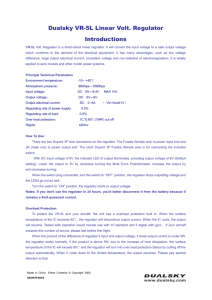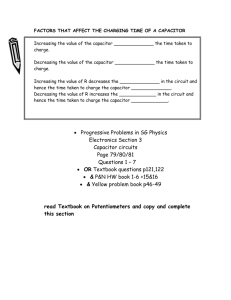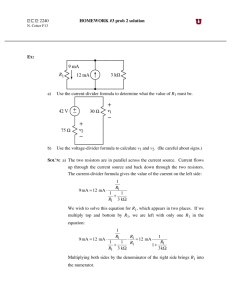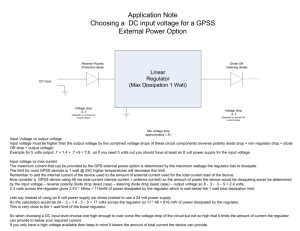Low-Stored-Energy 100-kV Regulator for Ion Sources at LANSCE
advertisement
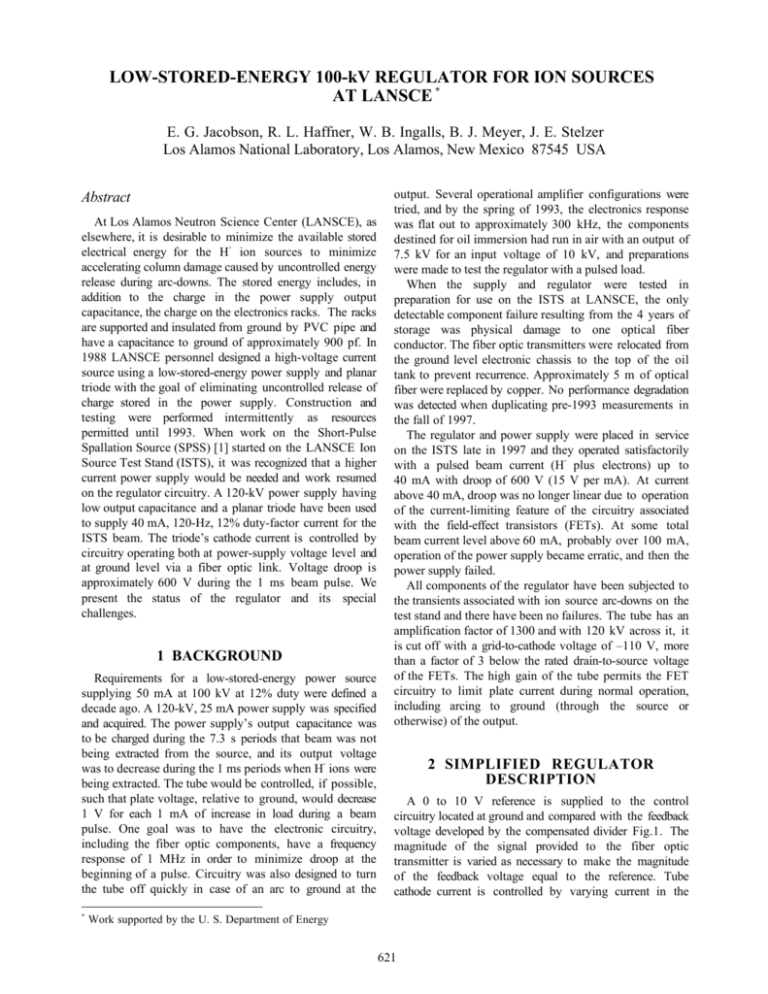
LOW-STORED-ENERGY 100-kV REGULATOR FOR ION SOURCES AT LANSCE * E. G. Jacobson, R. L. Haffner, W. B. Ingalls, B. J. Meyer, J. E. Stelzer Los Alamos National Laboratory, Los Alamos, New Mexico 87545 USA Abstract At Los Alamos Neutron Science Center (LANSCE), as elsewhere, it is desirable to minimize the available stored electrical energy for the H- ion sources to minimize accelerating column damage caused by uncontrolled energy release during arc-downs. The stored energy includes, in addition to the charge in the power supply output capacitance, the charge on the electronics racks. The racks are supported and insulated from ground by PVC pipe and have a capacitance to ground of approximately 900 pf. In 1988 LANSCE personnel designed a high-voltage current source using a low-stored-energy power supply and planar triode with the goal of eliminating uncontrolled release of charge stored in the power supply. Construction and testing were performed intermittently as resources permitted until 1993. When work on the Short-Pulse Spallation Source (SPSS) [1] started on the LANSCE Ion Source Test Stand (ISTS), it was recognized that a higher current power supply would be needed and work resumed on the regulator circuitry. A 120-kV power supply having low output capacitance and a planar triode have been used to supply 40 mA, 120-Hz, 12% duty-factor current for the ISTS beam. The triode’s cathode current is controlled by circuitry operating both at power-supply voltage level and at ground level via a fiber optic link. Voltage droop is approximately 600 V during the 1 ms beam pulse. We present the status of the regulator and its special challenges. 1 BACKGROUND Requirements for a low-stored-energy power source supplying 50 mA at 100 kV at 12% duty were defined a decade ago. A 120-kV, 25 mA power supply was specified and acquired. The power supply’s output capacitance was to be charged during the 7.3 s periods that beam was not being extracted from the source, and its output voltage was to decrease during the 1 ms periods when H- ions were being extracted. The tube would be controlled, if possible, such that plate voltage, relative to ground, would decrease 1 V for each 1 mA of increase in load during a beam pulse. One goal was to have the electronic circuitry, including the fiber optic components, have a frequency response of 1 MHz in order to minimize droop at the beginning of a pulse. Circuitry was also designed to turn the tube off quickly in case of an arc to ground at the * output. Several operational amplifier configurations were tried, and by the spring of 1993, the electronics response was flat out to approximately 300 kHz, the components destined for oil immersion had run in air with an output of 7.5 kV for an input voltage of 10 kV, and preparations were made to test the regulator with a pulsed load. When the supply and regulator were tested in preparation for use on the ISTS at LANSCE, the only detectable component failure resulting from the 4 years of storage was physical damage to one optical fiber conductor. The fiber optic transmitters were relocated from the ground level electronic chassis to the top of the oil tank to prevent recurrence. Approximately 5 m of optical fiber were replaced by copper. No performance degradation was detected when duplicating pre-1993 measurements in the fall of 1997. The regulator and power supply were placed in service on the ISTS late in 1997 and they operated satisfactorily with a pulsed beam current (H plus electrons) up to 40 mA with droop of 600 V (15 V per mA). At current above 40 mA, droop was no longer linear due to operation of the current-limiting feature of the circuitry associated with the field-effect transistors (FETs). At some total beam current level above 60 mA, probably over 100 mA, operation of the power supply became erratic, and then the power supply failed. All components of the regulator have been subjected to the transients associated with ion source arc-downs on the test stand and there have been no failures. The tube has an amplification factor of 1300 and with 120 kV across it, it is cut off with a grid-to-cathode voltage of –110 V, more than a factor of 3 below the rated drain-to-source voltage of the FETs. The high gain of the tube permits the FET circuitry to limit plate current during normal operation, including arcing to ground (through the source or otherwise) of the output. 2 SIMPLIFIED REGULATOR DESCRIPTION A 0 to 10 V reference is supplied to the control circuitry located at ground and compared with the feedback voltage developed by the compensated divider Fig.1. The magnitude of the signal provided to the fiber optic transmitter is varied as necessary to make the magnitude of the feedback voltage equal to the reference. Tube cathode current is controlled by varying current in the Work supported by the U. S. Department of Energy 621 • FET. For plate-to-cathode voltage of greater than 3 kV and plate current of less than 150 mA, grid-to-cathode voltage is negative and grid current is zero. Within those constraints, plate current is equal to FET current. (+) 120 KV 7 nF P.S. (–) Output Planar Triode 0-100 kV 5 FIBER OPTIC LINKS The printed circuit board in the oil tank has two fiber optic inputs from ground level. The analog control signal originates in the regulator module. A digital on-off signal comes from a transmitter that receives its input from an arc-down recovery card module that has several permissive inputs. The FET depicted in Figure 1 represents both the FET associated with the analog signal and the FET associated with the arc-down recovery card. Figure 2, though still simplified, is an expansion of the FET circuitry. FET 0-10 V Reference Light-emitting diodes that indicate circuit components’ status outside the tank via light fibers High-Voltage Input High-Voltage Output (+) 18 VP.S. (–) Analog Signal Figure 1: Simplified circuit diagram. Components represented by symbols inside the dotted line are in an oilfilled tank. The double arrows represent fiber optic transmission and detection. On-Off Signal 3 COMPONENTS AT GROUND LEVEL Reference to the summing junction of the regulator amplifier is provided by a 10.000 V, +/- 2.5 mV precision reference chip and a 10-turn potentiometer. The regulator amplifier is followed by three stages of amplification of gain seven each. The operational amplifiers used for these stages have a gain-bandwidth product of no less than 45 MHz. They are followed by a buffer amp of gain 0.9 which drives the fiber optic transmitter. The transmitter is mounted on the top of the oil tank. Resistor for Current Limit Function (+) 18 V P.S. (-) Figure 2: Simplified circuit diagram. Analog amplifier represents a detector diode and three stages of amplification. On-off amplifier represents a detector diode and a comparator. 4 COMPONENTS IN THE OIL TANK Devices located in the tank filled with electrical insulating oil are mounted on a plate that is supported by rods connected to the removable tank top. All components are accessible when the tank top is lifted. A 120:24 V isolation transformer rated 120 kVDC and the compensated voltage divider are mounted on the plate. Also attached to the plate is a phenolic support structure on which is mounted: • A printed circuit card holding the fiber optic receiver and three stages of amplification, FETs which provide on-off switching and cathode current control, and 18- and 23-V voltage regulators • Α 24:6 V filament transformer • Α planar triode and heat sink The output of a comparator on the card in oil ensures that the FET associated with the permissive signal from the arc-down recovery card is either fully enabled or disabled. When enabled (effectively a short circuit), control of current in the FETs, and consequently the planar triode, is provided by the FET whose gate signal is a function of the output of the ground-level regulator circuitry. 6 CONTROL RESPONSE The open-loop gain, from the reference input of the regulator to the gate of the controlling FET, is approximately 1600. Time to peak following an input step small enough not to cause any amplifier saturation, 622 2.5 mV through 1 kΩ into the summing junction, is approximately 850 ns. Time to reach steady-state is approximately 2.25 µs. Because of the limitations of the compensated divider, measurement of closed-loop response has been difficult due to the magnitude of the noise on the divider signal. Use of a commercial divider having a halfpower frequency response of 5.7 MHz has been used to observe what we think is a truer representation of voltage applied to the ion source on the ISTS. The regulator has supplied 40 mA, 1 ms pulses at 120 Hz with a droop from 80 kV of 600 V. 7 COMPENSATED DIVIDER The divider which generates the voltage feedback signal consists of three 300 pF vacuum capacitors and one 1 µF polystyrene capacitor in series that are in parallel with seventy-eight 1.283 MΩ resistors and one 10,001 Ω resistor in series. The 1.283 MΩ resistors are wound spirally around a phenolic tube that encloses the 300 pF capacitors. The first resonance of the vacuum capacitors, measured individually, in air, occurs at 33 MHz. The first resonance for the polystyrene unit occurs between 0.5 and 0.6 MHz. The change in effective capacitance when the assembly is submerged in oil is not known. However, total capacitance of the three vacuum capacitors before submersion in 1990 was 116 pF. After the resistor, capacitors, and phenolic tube had been submerged in oil for 4 years, measured total capacitance was 256 pF. Measured individually, the increases were 70 to 80 pF per resistor-capacitor section. The effects on regulator performance of the variation from ideal have not been determined. 8 FUTURE WORK AND CONCERNS The initial requirement of supplying a 50-mA pulsed load has changed to 100 mA and may be increased to 200 mA or more. A nonstandard power supply capable of 200 mA at 12% duty has been ordered. It is possible to add power supplies in parallel. The manufacturer’s experience with the planar triode indicates that, as operated in this application, it is capable of peak current of 350 mA without exceeding the anode dissipation capability of the tube or the tube’s emission capability. Due to consequences of consolidations within the vacuum tube industry, tube procurement lead time has been long. Considerable time was spent before 1992 in the effort to build a good high-frequency voltage divider. The original goal for frequency response had been 1 MHz for the electronics and 10 MHz for the divider. Although operation using the divider has been satisfactory, the signal it provides is noisy and needs to be improved. A chip capacitor whose first resonance is at 1.1 MHz is a possible replacement for the polystyrene capacitor if the chip’s relatively inferior stability would not be a problem. Although short, 4 cm, the connection between the plate, made on the heat sink bolted to the triode, and the top of the divider is inductive, and the effect of varying the length has been investigated only briefly. 9 CONCLUSIONS Regulation of -80 kV using a planar triode and a lowstored-energy power supply whose output droops from –120 kV during the time charge is being extracted from an ion source on the ISTS has been demonstrated. The capacity of the high-voltage supply has been exceeded with no apparent damage to the regulator components. With an adequate power supply and modifications to the FET current limit circuitry, which floats at high voltage, it is anticipated that up to 350 mA at 12% duty could be supplied by the regulator using the present planar triode. Future work will include investigation of the response time of on-off FET circuitry, reduction of compensated divider noise, determination of the cause(s) of the higherthan-designed-for droop, and testing with the new power supply. ACKNOWLEDGMENT Andrew A. Browman was the initial designer of the regulator, provided solutions to circuit limitations as they became apparent as portions were constructed and tested, and has continued to provide valuable suggestions when requested. REFERENCE [1] R. R. Stevens et al., “Beam Simulations for the HUpgrade at LANSCE,” Proceedings of LINAC98, Chicago, August 23-28, 1998. XXX-XXX (1998). 623
